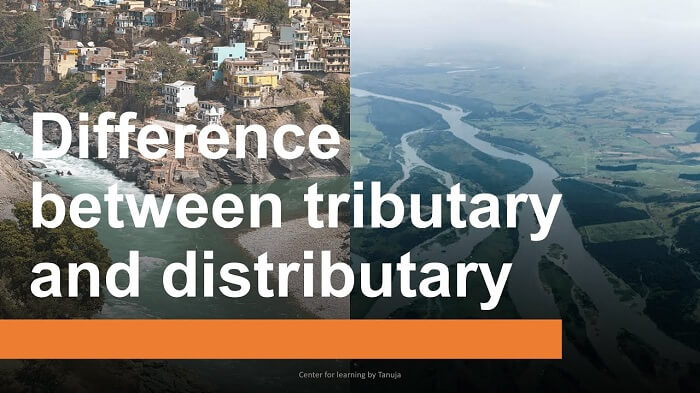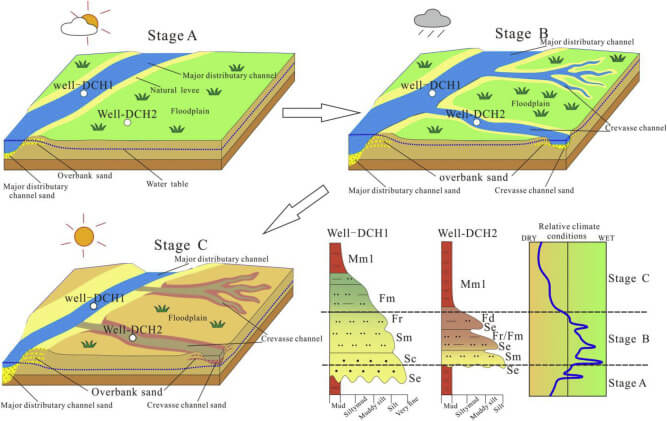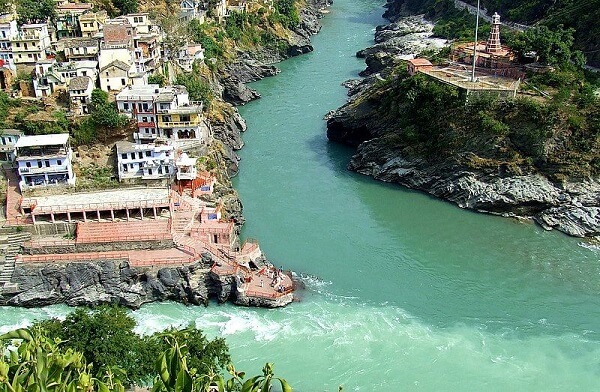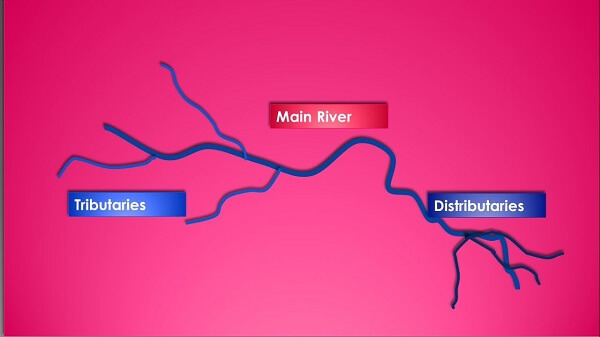Difference Between Tributary And DistributaryIntroductionTributary and distributary are two types of rivers that are important for ecology and human activities. They are often confusing terms but are two different types of waterways with distinct characteristics. This article will explore the differences between tributary and distributary rivers to understand their unique features and roles better. 
Tributaries and distributaries are the types of rivers in many parts of the world. They are both essential components of the hydrological cycle and play an important environmental role. Both rivers are formed due to the natural flow of a river, but there are some distinct differences between them. Water is a precious resource that has shaped the course of human civilization. It is essential for the sustenance of life. Rivers are one of the most critical water sources and play a significant role in developing societies. Tributaries and distributaries are two terms commonly used to refer to the parts of a river. Tributary RiversA tributary is a river or stream that flows into a larger body of water, such as a lake, ocean, or main river. The main river is called the parent river, while the small rivers that flow into the larger one are called tributaries. Tributaries can be small streams, creeks, or larger rivers that feed into the parent river. Tributary rivers are usually separated from the main river by a ridge called a divide. This divide can be caused by different elevations between the two rivers or geological forces such as volcanism. Tributaries often have drainage basins and may be part of a more extensive river system. The water in a branch is typically fed from a source, such as a mountain spring or groundwater, and is then carried downstream to its destination. Tributaries are essential for many reasons, including providing fresh water, transferring sediment, and providing a means for aquatic organisms to migrate. Distributary RiversA distributary, or a distributary channel, is a river or stream that branches off from a main river and flows away in a different direction. Unlike tributaries, distributaries do not rush into a larger body of water but drift away from it instead. Distributaries are often smaller than the main river and can be found in estuaries, deltas, and other areas where the main river splits into two or more branches. Distributaries can also form when a river is artificially altered, such as when a canal is dug to divert water for irrigation or other purposes. In some cases, a distributary may eventually rejoin the original river after flowing for some distance. 
Distributaries play an essential role in the ecology of a river system. They help to spread out the flow of the main river, which can help to reduce flooding. Distributaries also provide food and nutrients for the main river and a habitat for fish and other aquatic species. Distributaries are common in estuaries, where the river meets the sea, and in delta systems, where the river flows into a larger body of water. Distributaries are essential to the hydrological cycle and provide significant benefits, including sediment transfer and the river system's integrity. Differences between Tributary and Distributary RiversThe main difference between tributary and distributary rivers is the flow direction. Tributary rivers flow into a larger body of water, while distributary rivers split off from the main river and flow away. 
Another difference between tributary and distributary rivers is their size. Tributary rivers are typically larger than distributary rivers and may be part of a more extensive river system. Distributary rivers are typically smaller than the main river and may be part of a minor river system. The role of tributary and distributary rivers in the ecology of a river system is also different. Tributaries provide a source of water for the parent river, which can help to replenish the water supply and prevent the main river from drying up. Distributaries help to spread out the flow of the main river, which can help to reduce flooding. Tributaries and distributaries provide food and nutrients for the main river and a habitat for fish and other aquatic species. The most notable difference between tributaries and distributaries is the direction in which they flow. Tributaries flow into the parent river, while distributaries flow away from the main stem. Tributaries are usually smaller than the main stem, while distributaries are typically more significant than the main stem. Tributaries are the primary water source for the parent river, while distributaries are usually the primary source of sediment and other materials. CharacteristicsTributaries are typically smaller than the main river they flow into and can vary significantly in size. They are usually found in the upper reaches of a river system and originate from springs, snowmelt, or rainwater. Tributaries, such as mountain streams or a lake, are often identified by their source. Additionally, they usually have a steeper gradient than the main river they flow into, which helps to create a more dynamic flow. Distributaries are typically larger than tributaries and are usually found in the lower reaches of a river system. They are often identified by their destination, such as a lake or an estuary. Additionally, they often have a gentler gradient than the main river they flow away from, which helps to create a slower, more meandering flow. FunctionsTributaries are essential components of the hydrological cycle. They provide fresh water to downstream locations and transfer sediment, which helps to maintain the integrity of the river system and its habitat. Additionally, tributaries are essential for aquatic organisms, providing them a means to migrate, breed, and feed. Distributaries are also formed when a river divides or bifurcates into two or more mouthparts. They are important for transportation, as ships can use them to reach inland areas, and for irrigation, as the water can be used for agriculture. They also provide recreational areas for activities such as fishing and boating. Additionally, distributaries are important for the environment, as they help to reduce flooding and protect coastal areas from the effects of storms and hurricanes. Similarities Between Tributary and DistributaryTributaries and distributaries are both parts of a river system. They both contribute to water flow in a river and are essential for the sustenance of life. Difference in SizeThe primary difference between tributaries and distributaries is the size of the river or stream. Tributaries are typically smaller in size and volume than the main body of water they feed into. Distributaries are generally smaller in size and importance than the main body of water they branch from. Tributaries are usually smaller than the main stem, while distributaries are typically more significant than the main stem. This is because tributaries are formed when a river splits into multiple channels, while distributaries are formed when a river splits into a single track. This size difference is also due to the varying topography of the land surrounding each part of the river. Tributaries are typically found in higher-elevation areas, while distributaries are in lower-elevation areas. LocationAnother critical difference between tributaries and distributaries is their location relative to the main body of water. Tributaries are typically located upstream of the main body of water, while distributaries are typically downstream. This difference in location is what sets them apart from one another. Flow DirectionThe flow direction of a tributary and distributary is also different. Tributaries generally flow into the main body of water, while distributaries flow away. This difference in flow direction is what allows the two to be separated. The most fundamental difference between tributaries and distributaries is the direction in which they flow. Tributaries flow into the parent river, while distributaries flow away from the main stem. This difference is due to the varying topography of the land surrounding each part of the river. Tributaries are typically found in higher-elevation areas, while distributaries are in lower-elevation areas. 
Water MixingThe water from a tributary and distributary eventually mixes with the water from the main body. This is why it is essential to understand the difference between the two. Branches are typically located upstream of the main body of water, so the water from the tributary will mix with the water from the main river or lake before the water from the distributary does. UsesTributaries and distributaries have several different uses. Branches are often used for irrigation, other agricultural purposes, and recreational activities such as fishing. Distributaries are sometimes used for navigation and the transportation of goods. Source of WaterTributaries are the primary water source for the parent river, while distributaries are usually the primary source of sediment and other materials. Tributaries bring fresh water and sediment into the main stem, while distributaries transport sediment and other materials away from the main branch. Difference Table
ConclusionTributary and distributary rivers are very different types of rivers with distinct characteristics. Tributary rivers flow into a larger body of water, while distributary rivers split off from the main river and flow away. Tributaries are usually larger than distributaries, and their roles in the ecology of a river system are also different. Tributaries provide a water source for the parent river, while distributaries help spread out the flow of the main river. Tributaries and distributaries play an essential role in the ecology of a river system, providing a source of food and nutrients for the main river and a habitat for fish and other aquatic species. Tributaries and distributaries are essential components of the hydrological cycle, and both play important roles in the environment. Tributaries are usually smaller and are found in the upper reaches of a river system. At the same time, distributaries are typically larger and are located in the lower reaches of a river system. Both rivers provide essential benefits, including the transfer of sediment and the maintenance of the integrity of the river system. Tributary and distributary are two terms often confusing when discussing a river system. While they are related to rivers and streams, they differ.
Next TopicDifference between
|
 For Videos Join Our Youtube Channel: Join Now
For Videos Join Our Youtube Channel: Join Now
Feedback
- Send your Feedback to [email protected]
Help Others, Please Share










